Opinion
MoMA Gives Us the ‘Romantic-Realist’ Marcel Broodthaers That We Deserve
The current retrospective comes as a nice surprise.
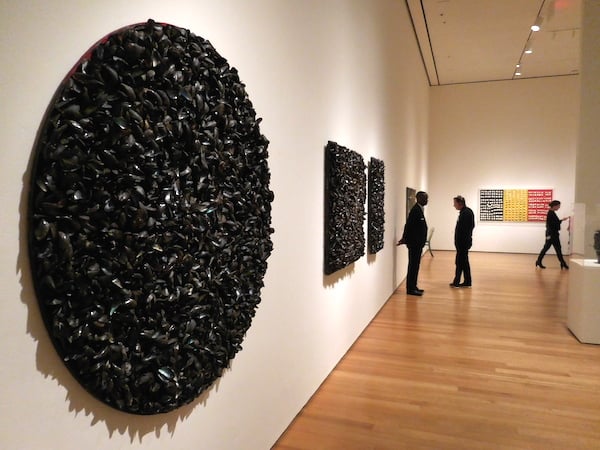
The current retrospective comes as a nice surprise.

Ben Davis

“First,” Marcel Broodthaers once said, “we let the critics and art historians make their errors.” In fact, this oddball Belgian artist (1925-1976) has long been a darling of both critics and art historians—and it may be about time to save him from his own champions.
The loudest voices within the voluminous Broodthaers literature make him come off as either mainly concerned with undercutting other artists’ ideas of art (Thierry de Duve), or with negation (Benjamin Buchloh), or with whatever “the enactment of a kind of layering that can itself stand for, or allegorize, the self-differential condition of mediums themselves” means (Rosalind Krauss). He therefore comes across as rather stilted, academic, and inhuman.
So the current Museum of Modern Art retrospective in New York comes as a nice surprise. It mainly succeeds in making Broodthaers read as the romantic realist that his widow, Maria Gilissen Broodthaers, insists he always actually was.
It gives the breadth of his art room to breathe. It ranges from a rebus-like experimental film telling a French fairy tale (also on display, incidentally, in a concurrent show at Michael Werner gallery on the Upper East Side), to a full-sized recreation of his own Brussels apartment—the walls studded with words relating to art-making (“Canvas,” “Museum,” “Composition,” etc.). It’s the stuff of daily life turned into a simulation and entombed by a critical vocabulary, which is sort of fitting.
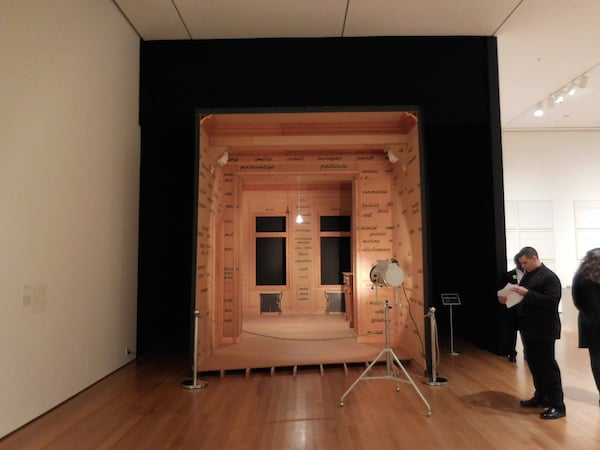
Marcel Broodthaers, La sale blanche (The White Room) (1975).
Image: Ben Davis.
As an artist, Broodthaers took the puzzle-aesthetic of Marcel Duchamp, and stirred it together with the drawing-room Surrealism of his countryman René Magritte, a personal friend whom he met in 1945, when he was 20 and the elder man was 47.
To understand what this admixture meant to Broodthaers, you have to go back to the decades before his artistic success—the immediate post-war period in Europe with its dislocation and disarray and rapid transformation. Then, Broodthaers was a militant young poet, actively engaged with debates about art’s role in society that emerged from the collision of the day’s two main intellectual currents: Surrealism and Marxism. (He was a member of the Communist party from 1943 to 1951).
In 1947, Broodthaers, along with a variety of other artists, responded to a questionnaire conceived of by Magritte for the magazine Le savoir vivre. In his answers, he struck a pose of bohemian disdain for convention, but also kept circling back to the subject of his own financial plight.
What do you detest?, the questionnaire asked. “Those who follow ‘good’ popular proverbs which only allow just enough to be able to live; also poverty.” What do you wish the most? “Certain unspecified vulgar things; money obviously because being especially deprived of this means I am really embarrassed.”
Broodthaers early works often feature two signature materials, mussel shells and egg shells, glued onto canvasses or piled up into sculptural accumulations. Such materials are often thought of for their Surrealist associations, or, in the case of the mussels, as plays on “clichés of Belgian culinary identity.”
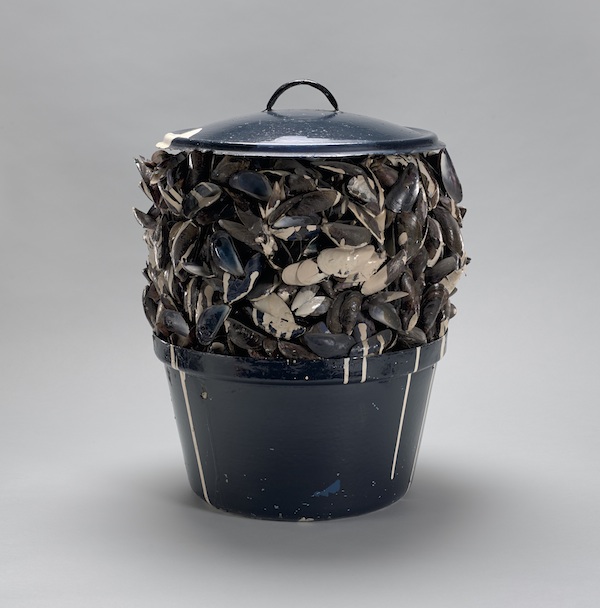
Marcel Broodthaers, Moules sauce blanche (Mussels with white sauce) (1967)
Image: Private collection, New York. © 2016 Estate of Marcel Broodthaers / Artists Rights Society (ARS), New York / SABAM, Brussels
I get those associations, but I also see hunger—the hunger of a starving poet who has spent long periods looking in at the restaurants through the glass.
In 1964, Broodthaers decided to turn his talents to visual art. By that time, Duchamp’s dandyish pronouncements and inscrutable found objects were starting to have their catalytic effect on visual art. Across the Atlantic, in New York, the Frenchman had been discovered by the likes of Jasper Johns and Robert Rauschenberg, and then a younger generation of insurgent conceptual artists.
Back in 1961, Rauschenberg had sent a telegraph to Paris’s Iris Clert Gallery, which simply stated “This is a portrait of Iris Clert if I say it is”—the message of Duchampianism literally beamed back to the Old Country. Meanwhile, in Europe, Piero Manzoni was selling “Artist’s Shit” and Yves Klein was offering his “pictorial sensitivity” for sale in exchange for payment in gold.
So just imagine: You are a poet who has spent several decades in destitution, committing oneself to crafting intimate and intricate symbolist poetry. Now imagine there are artists making reputations and a seemingly good living peddling arch, circular aphorisms and jokes. It might provoke in you a kind of midlife crisis, as it did for Broodthaers.
The invitations to Broodthaers’s first gallery show, at Galerie St. Laurent in Brussels, were printed on pages of popular magazines (which are displayed at MoMA) with a text that states, in part, “I, too, wondered whether I could not sell something and succeed in life. For some time I had been no good at anything. I am forty years old… Finally the idea of inventing something insincere finally crossed my mind and I set to work straightaway.”
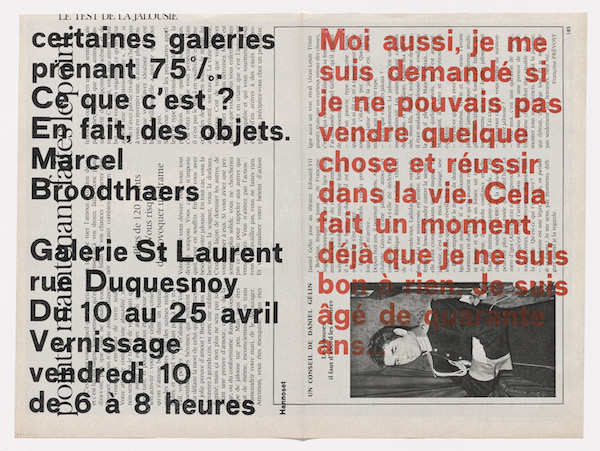
Marcel Broodthaers, Moi aussi, je me suis demandé si je ne pouvais pas vendre quelque chose et réussir dans la vie . . . (I, too, wondered whether I could not sell something and succeed in life . . .)(1964).
Image: Museum of Modern Art, New York. © 2016 Estate of Marcel Broodthaers / Artists Rights Society (ARS), New York / SABAM, Brussels
The statement is freighted with cynicism. I take it at face value.
Thus, the centerpiece of that show was a sculpture composed of a bunch of unsold copies of his own book of poems, Pense-Bête (Memory Aid), partially entombed in plaster, a weird plastic orb also peeking out from the groaty white mass like a chintzy tumor. It looks deliberately half-cooked as a sculpture. But the gambit of reframing his carefully crafted verse as deliberately sloppy art actually worked; the audience liked it.
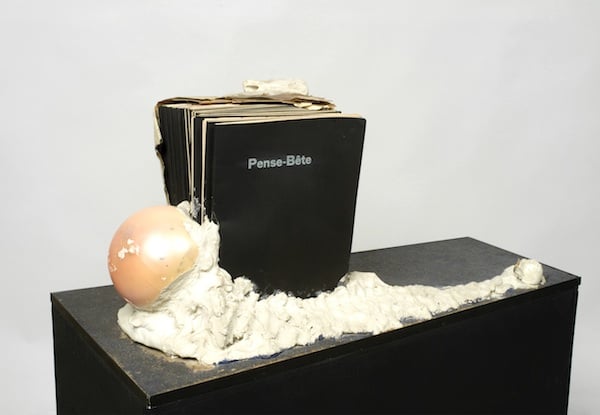
Marcel Broodthaers, Pense-Bête (Memory aid) (1964).
Image: Collection Flemish Community, long-term loan S.M.A.K. © 2016 Estate of Marcel Broodthaers / Artists Rights Society (ARS), New York / SABAM, Brussels
Broodthaers’s ensuing, wildly productive career would be relatively brief, cut short by liver disease. In the meantime, he passed through a number of permutations, but the one that made his reputation was his multi-part, touring Musée d’Art Moderne initiative, which he began in the middle of 1968.
Art history, Arnold Hauser once said, rarely makes any decisive leaps forward on its own. Challenging new styles need a push from without. Broodthaers’s big breakthrough is a perfect illustration of the maxim: In May 1968, Paris exploded. Fueled by student revolt against the authoritarian politics and social conservatism of Charles de Gaulle’s France, the uprising paralyzed the country and had reverberations around the world.
A few hours to the north in Brussels, one of these reverberations was an occupation of the Palais des Beaux-Arts by students and artists; Broodthaers was spokesman for the short-lived action. And when, a few months later, a group of “artists, collectors, gallery people” (Broodthaers’s description) wanted to do a teach-in continuing the discussion about art and politics in Belgium, they agreed to meet at Broodthaers’s studio.
He expected a crowd commensurate with the size of the interest generated by the occupation of the museum. Thus, he scrounged crates for people to sit on, decorated his space with postcards of art, and as a conversation prompt stuck the words “Museum” on the door. Later a curator, doing what curators do, would invite him to restage this talk-space as an artwork for a show in Düsseldorf, a proposition that he first resisted on the grounds that the original action had been “against the established institution of the museum.”
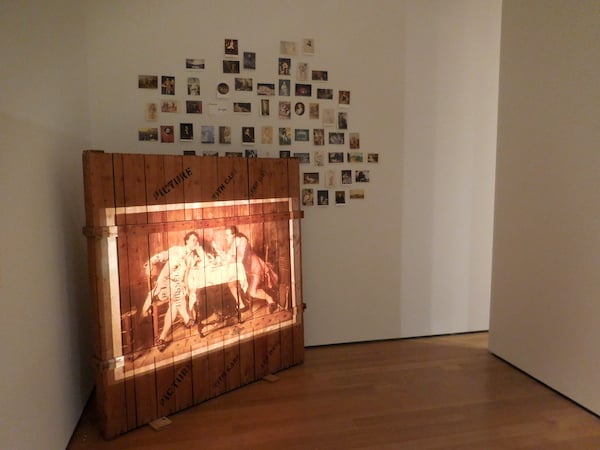
Recreation of the original Musée d’Art Moderne installation at MoMA
Image: Ben Davis
The MoMA show presents the final incarnation of the initiative, Musée d’Art Moderne: Publicity Section, shown at Documenta in 1972 at the invitation of the important curator Herald Szeeman. What you see is, in essence, a slideshow comparing hundreds of images of borrowed artifacts, from fine art to cigarette ads to random curios, all united only by the fact that they featured the image of an eagle.
For his Museum, Broodthaers played at being both a curator and a museum director; for this work in particular, he also plays at being the art historian, the slideshow comparison of details being a basic classroom tool. John Berger’s classic BBC documentary Ways of Seeing came out the same year, and also stressed links between Old Masters and commercial visual culture, also to show that the museums were full of unspoken ideology: the dignified materialism of Dutch still-lifes compared to the magical glow of products in magazine ads; classic nudes compared to Playboy pinups. This kind of criticism of art was in the air.
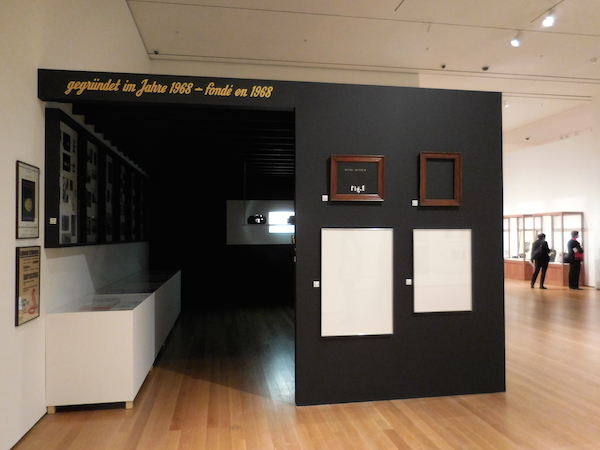
Installation view of Marcel Broodthaers, Section Art Moderne et Publicité (Publicity section of the Musuem of modern art, Department of eagles) (1975)
Image: Ben Davis
Thus, Broodthaers installation was critical catnip; every detail has been duly read as if it were a line in a philosophical treatise. Yet I think it important to emphasize how, as the artist himself said, the whole thing was born, “not out of a concept, but out of a circumstance, the concept came later.”
The idea of a “section of eagles,” scrawled on the garden wall of his studio in 1968 for that first teach-in, had been seemingly a characteristically poetic way to allude to the topic of that discussion: art, museums, and power. Only four years later did he hit upon the idea of making it about literal images of eagles, and that after many pop-up versions of the show. (In August 1969, for the eagle-less Musée d’Art Moderne: Documentary Section, for instance, he had traced a museum floor plan on a beach, put up some signs telling people not to touch the non-existent art, and waited for the tide to bring the joke to an end.)
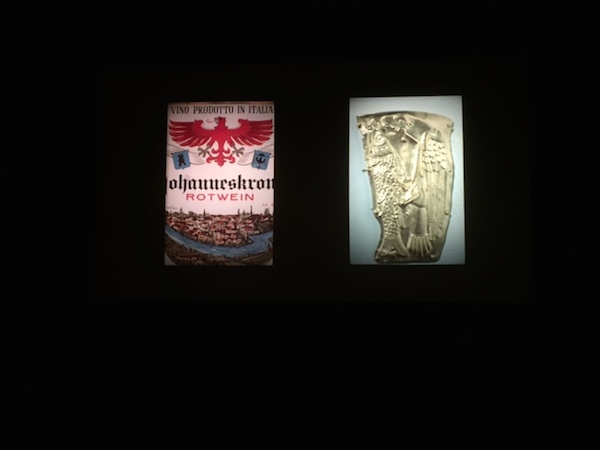
Detail of the Musuem of Modern Art, Department of Eagles (1975).
Image: Ben Davis.
The whole initiative is sometimes read as a harbinger of “institutional critique,” but Broodthaers’s actual aims were modest on that front: “We weren’t up in arms against the institutions,” Broodthaers collaborator Isi Fiszman remembered later (quoted in Christian Rattemeyer’s great summary of the Musée d’Art Moderne’s history from the MoMA catalogue), “but here, in Belgium, we had institutions that were so bad, and we didn’t see why there couldn’t be good institutions. As a reaction to this, Marcel was the first to set up his own museum.”
Broodthears’s Musée d’Art Moderne is his most didactic work, powered by the anti-establishment soul-searching brought on by May ’68—but it’s a lyrical brainteaser, not a righteous denunciation. You can produce (and critics have produced) readings of it as a critique of the insidious connections of the classical museum to state power; or of the permissiveness of contemporary art, putting junk on the same level as the masters; or as a philosophical statement about the impossibilities of classification as such. Still, the obvious but important fact is that Broodthears does all this through a rather whimsical device; on the surface, its exact message remains somewhat inscrutable, elusive, or, you could say, poetic.
“I believe my exhibitions depended and still depend on memories of a period when I assumed the creative situation in a heroic and solitary manner,” Broodthaers said in 1974, referring back to his starving poet days. Though he adopted and mastered the game of contemporary art, Broodthaers was cynical about it. In fact, he retained a very 19th-century, slightly out-of-time vision of artistic capacity. He loved the prophetic language games of Stéphane Mallarmé (a poet to whom Magritte himself had introduced him, and to whose opus Un Coup de Dés Jamais N’Abolira Le Hasard he paid homage in quite a few works) and the incantatory intensity of Charles Baudelaire. Yet his personal experience as a poet told him that visionary lyricism did not have much of a purchase on the present.
A current of wry, compromised nostalgia runs throughout the MoMA show, maybe best seen in a concluding pair of rooms devoted to Broodthaers’s so-called “Décors,” proto-installation environments evoking half-finished stage sets or period rooms. One is called the “19th Century Room,” the other the “20th Century Room.”
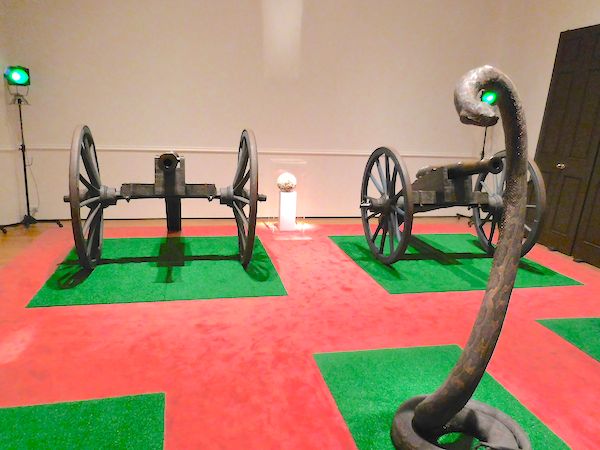
Marcel Broodthaers, Decor: A Conquest by Marcel Broodthaers (1975).
Image: Ben Davis.
The “19th Century Room” is red-carpeted, with antique furniture, potted plants, and a pair of ominous canons. These evoke an era of slaughter and conquest, but there’s a note of romantic affectation: the cannonball displayed on a pedestal between the cannons is studded with flower blossoms. At the center of the room, a giant, stuffed snake rears up ominously. Yet to one side, another vitrine features a crab playing a lobster at cards, a whimsical touch that seems out of a Lewis Carroll book.
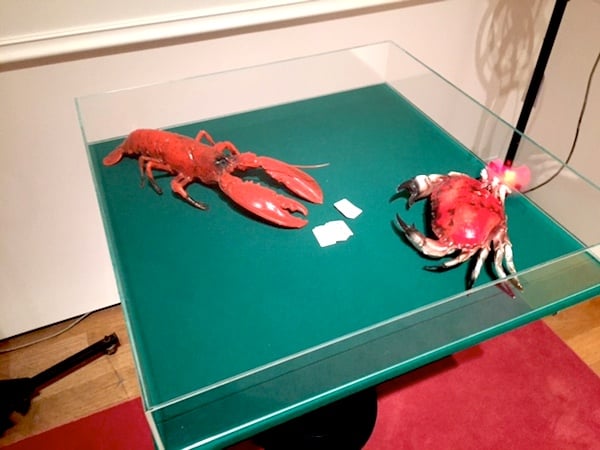
Detail of Marcel Broodthaers, Decor: A Conquest by Marcel Broodthaers (1975).
Image: Ben Davis.
The comparison to the “20th Century Room” is telling, and, for an artist known for indirection, suggests a verdict unusual in its finality.
It has a gray carpet that evokes bureaucratic office space; some patio furniture; a table bearing a half-completed jigsaw of the Battle of Waterloo. On the wall behind these: a plain white shelf laden with rows of military rifles. Below, a picture of pistols juxtaposed above a display of actual pistols, image and object juxtaposed in the classic Conceptual Art manner. The space is arid, ominous.
Disenchanted brutality and a relation to an epic past reduced to a puzzle—that, at last, was what Broodthaers saw his own time as offering.
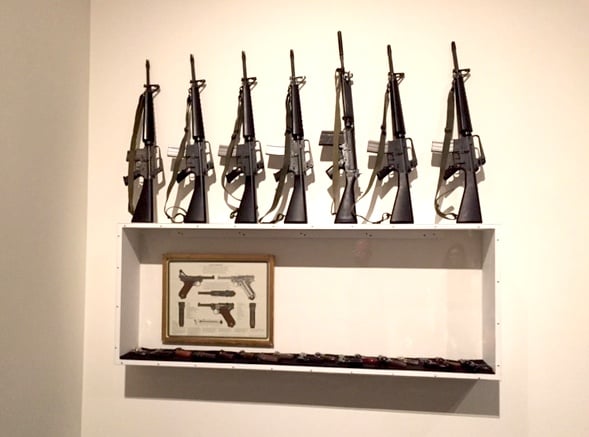
Detail of Marcel Broodthaers, Decor: A Conquest by Marcel Broodthaers (1975).
Image: Ben Davis.
“Marcel Broodthaers: A Retrospective” is on view at the Museum of Modern Art, through May 15, 2016.